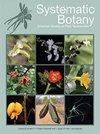岩石雏菊的系统发育再分类;菊科)
IF 0.8
3区 生物学
Q4 EVOLUTIONARY BIOLOGY
引用次数: 1
摘要
摘要近期对岩雏菊属植物叶绿体和核基因组序列数据的系统发育分析以及形态学和细胞学分析解决了岩雏菊族(Perityleae;并支持在属级上重新分类以反映进化关系。先前承认的Eutetras属和Pericome属被维持为支系,并在新的分类中继续被承认。在以前的分类中,大属Perityle被发现不是单系的,因此被重新分类为四个属,使用现有的名称Laphamia(扩展意义),Galinsogeopsis(扩展意义),Nesothamnus和Perityle(新限制意义)。Perityle的模式种属于岩雏菊部落的早期分化谱系,在一个染色体数目不同的分支中,x = 11、12、13、16、18或19。除了类型(加利福尼亚卷叶虫),卷叶虫现在还包括卷叶虫的其他6个最低等级分类群,Amauria的所有3个分类群,以及Desventuradas群岛特有的Lycapsus tenuifolius。Nesothamnus被恢复为瓜达卢佩岛特有灌木Nesothamnus incana的单型属。Laphamia和Galinsogeopsis共同构成了一个木本和草本多年生或一年生植物的分支,其稳定的碱基染色体数为x = 17 (n = 17, 34, 51, 68),在整个盆地和山脉省以及美国西南部和墨西哥北部的西马德雷山脉(Sierra Madre Occidental)多样化。Laphamia和Galinsogeopsis具有重叠的地理分布,但可以通过果实和花朵性状的组合来区分。这种新的伞叶属属分类解决了长期以来关于伞叶属范围的冲突,没有将伞叶属扩展到整个伞叶亚族,并承认北美西部岛屿状岩石栖息地的两个独立进化辐射是这个迷人的复合部落的分类不同的组成部分。为了允许这一修订的分类学,提供了Galinsogeopsis, Laphamia和Perityle的46个新组合,并采用了一个新名称Laphamia sanchezii。本文章由计算机程序翻译,如有差异,请以英文原文为准。
A Phylogenetically Informed Reclassification of the Rock Daisies (Perityleae; Compositae)
Abstract Recent phylogenomic analyses of sequence data from chloroplast and nuclear genomes as well as morphological and cytological analyses resolved long standing phylogenetic uncertainty in the rock daisy tribe (Perityleae; Asteraceae) and support reclassification at the generic level to reflect evolutionary relationships. The previously recognized genera Eutetras and Pericome were upheld as clades and continue to be recognized in the new classification. The large genus Perityle as treated in previous taxonomies was found not to be monophyletic and is thus reclassified in four genera, using the available names Laphamia (in an expanded sense), Galinsogeopsis (in an expanded sense), Nesothamnus, and Perityle (in a newly restricted sense). The type species of Perityle belongs to an early diverging lineage of the rock daisy tribe, in a clade with varied chromosome numbers of x = 11, 12, 13, 16, 18, or 19. In addition to the type (Perityle californica), Perityle now includes six other minimum-rank taxa of Perityle, all three taxa of Amauria, and the Desventuradas Islands endemic Lycapsus tenuifolius. Nesothamnus is reinstated as a monotypic genus for the Guadalupe Island endemic shrub Nesothamnus incana. Laphamia and Galinsogeopsis together constitute a clade of woody and herbaceous perennials or annuals with a stabilized base chromosome number of x = 17 (n = 17, 34, 51, 68) that have diversified throughout the Basin and Range Province and the Sierra Madre Occidental of the southwest US and northern Mexico. Laphamia and Galinsogeopsis have overlapping geographic distributions but can be distinguished by a combination of fruit and flower traits. This new generic classification of Perityleae resolves long standing conflict about the circumscription of Perityle without expanding the genus to encompass the entire subtribe Peritylinae and recognizes two independent evolutionary radiations onto island-like rocky habitats in western North America as taxonomically distinct components of this fascinating tribe of composites. To allow for this revised taxonomy, 46 new combinations in Galinsogeopsis, Laphamia, and Perityle are provided, and one new name, Laphamia sanchezii, is adopted.
求助全文
通过发布文献求助,成功后即可免费获取论文全文。
去求助
来源期刊

Systematic Botany
生物-进化生物学
CiteScore
1.80
自引率
10.00%
发文量
72
审稿时长
6-12 weeks
期刊介绍:
Systematic Botany Monographs is a series of peer-reviewed taxonomic monographs and revisions published the American Society of Plant Taxonomists. ISSN 0737-8211, ISBN prefix 978-0-912861. No; volumes of Systematic Botany Monographs must be ordered separately. ASPT membership inludes only a subscription to the quarterly journal Systematic Botany. SBM is supported by sales, author"s subsidies, and donations.
 求助内容:
求助内容: 应助结果提醒方式:
应助结果提醒方式:


